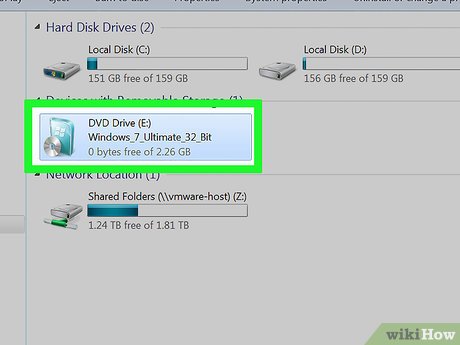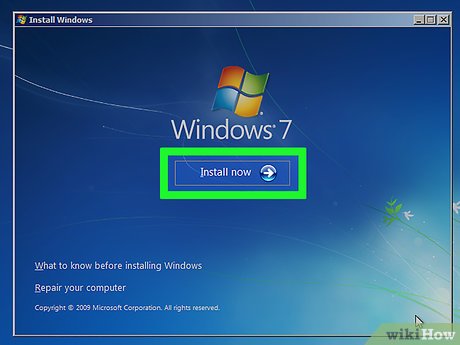How to Move on After Windows XP End of Support
Method 1 of 2:
Upgrading your OS
-
 Insert your Windows Installation media, whether it would be a disc, or a USB flash drive. For this example, we will use Windows 7 media.
Insert your Windows Installation media, whether it would be a disc, or a USB flash drive. For this example, we will use Windows 7 media. -
 Open the setup program. Open Windows Explorer, navigate to your media, and run "Setup.exe".
Open the setup program. Open Windows Explorer, navigate to your media, and run "Setup.exe".- You can also boot from the installation media. Make sure the setting in your BIOS is on if you decide to boot from the media. This is required if you are dual-booting.
- Click Install Now when prompted.
- For users who are upgrading, the option "Check Compatibility Online" may appear with "Install Now".
-
 Click "Go online to get the latest updates for installation (Recommended)". After Setup starts, you may be asked if you would like to receive the latest updates for installation. Getting updates ensures that installation succeeds and update your PC.
Click "Go online to get the latest updates for installation (Recommended)". After Setup starts, you may be asked if you would like to receive the latest updates for installation. Getting updates ensures that installation succeeds and update your PC. -
 Choose your Windows Edition. Depending on your media, you may be asked to choose the edition of Windows to install.
Choose your Windows Edition. Depending on your media, you may be asked to choose the edition of Windows to install.- Always make sure your product key matches the correct version of Windows.
- Keep in mind that your system cannot run a 64-bit OS without a 64-bit capable processor.
-
 Choose if you will upgrade or clean install. Clean Installs don't keep files & settings.
Choose if you will upgrade or clean install. Clean Installs don't keep files & settings.- You cannot upgrade a 32-bit edition to a 64-bit edition, and vise versa.
- Upgrading will keep files and settings. Your PC will check compatibility with Windows 7.
- Some XP users may not be able to directly upgrade. You may need to clean install.
-
 Make sure the license terms are accepted, and setup will begin. Setup may take several hours, so be patient.
Make sure the license terms are accepted, and setup will begin. Setup may take several hours, so be patient.- It is normal for your PC to restart several times and flash.
- If the prompt "Press any key to boot from CD or DVD" appears during a setup restart, do not press a key. Windows will proceed to boot from setup.
-
 When setup is complete, enter a username and computer name. After that, proceed with the on-screen instructions.
When setup is complete, enter a username and computer name. After that, proceed with the on-screen instructions. -
 Enter your 25-character Windows product key. The product key is similar to this:XXXXX-XXXXX-XXXXX-XXXXX-XXXXX
Enter your 25-character Windows product key. The product key is similar to this:XXXXX-XXXXX-XXXXX-XXXXX-XXXXX- Type your key slowly, and ensure you typed it correctly.
- DO NOT illegally get product keys. You should purchase a legal, genuine product key.
-
 Find yourself at the desktop. Click the Start Orb, and click "Getting Started" to help you get started with your new version of Windows.
Find yourself at the desktop. Click the Start Orb, and click "Getting Started" to help you get started with your new version of Windows.
Method 2 of 2:
Staying on Windows XP
-
 Download a reputable antivirus and anti-malware program. These apps protect your PC from malicious software and attackers.
Download a reputable antivirus and anti-malware program. These apps protect your PC from malicious software and attackers.- There are fake software programs that claim to be anti-viruses. One clue to help identify imposters is that they usually ask for money for a full version that removes malware. They may also show exaggerated results.
-
 Download a fast, stable browser. Internet Explorer 8, the latest version of IE compatible with XP, is unsupported. It exposes your PC to additional threats. Two good alternatives are Google Chrome and Firefox.
Download a fast, stable browser. Internet Explorer 8, the latest version of IE compatible with XP, is unsupported. It exposes your PC to additional threats. Two good alternatives are Google Chrome and Firefox.- Chrome is ending support for XP soon, so keep that in mind.
-
 Make sure you have all Windows Updates prior to the end of support. These updates help protect your PC and speed it up.
Make sure you have all Windows Updates prior to the end of support. These updates help protect your PC and speed it up. -
 Perform basic maintenance tasks, such as cleaning junk files and defragmenting your hard drive. These help speed up your PC.
Perform basic maintenance tasks, such as cleaning junk files and defragmenting your hard drive. These help speed up your PC. -
 Have installation media ready, in case you need to clean install.
Have installation media ready, in case you need to clean install.- Have a product key with it.
4 ★ | 1 Vote














 How to Give Your Windows Desktop a Makeover Using Rainmeter and Fences
How to Give Your Windows Desktop a Makeover Using Rainmeter and Fences How to Troubleshoot Aero Effect Issues
How to Troubleshoot Aero Effect Issues How to Update Video Card Drivers in Windows
How to Update Video Card Drivers in Windows How to Use Sendspace Wizard Desktop Tool on Windows
How to Use Sendspace Wizard Desktop Tool on Windows How to Transfer Files from Windows to iPad with HP All in One Printer Remote
How to Transfer Files from Windows to iPad with HP All in One Printer Remote How to Protect Kids' Online Safety on Windows
How to Protect Kids' Online Safety on Windows